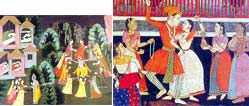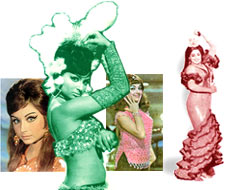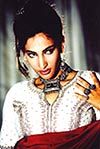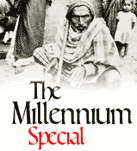The well known fashion designer on the landmarks in Indian fashion
 When we talk about Indian fashion, we have to take a completely different perspective. Ours is such a historic country -- there's such an unbelievable tradition, a vast heritage. We are really talking about 16 or 18 countries taken together -- each state has its own tradition -- really, Maharashtrian dress has nothing to do with Bengal, Bengal has nothing to with UP, UP has nothing to with Rajashthan. Every state is so distinct, so different. The only tragedy is that very little of this was documented.
When we talk about Indian fashion, we have to take a completely different perspective. Ours is such a historic country -- there's such an unbelievable tradition, a vast heritage. We are really talking about 16 or 18 countries taken together -- each state has its own tradition -- really, Maharashtrian dress has nothing to do with Bengal, Bengal has nothing to with UP, UP has nothing to with Rajashthan. Every state is so distinct, so different. The only tragedy is that very little of this was documented.
In the West, you'll see that fashion today is strongly based on the last three centuries. But in India, there is hardly anything on these centuries. There are no photographs -- the only idea you get about garments is from the miniature paintings. But till about the 1800s, very late 1800s, there was nothing. Even then, only the nobility, the aristocracy, the Maharajas were photographed. So their extremely elaborate, ceremonial way of dressing is what forms the basis of Indian fashion today.
The first major influence was the Persian, the Mughal one. The whole fusion of textile and new forms of fashion took off here -- the brocade, the kamarbandh.
 The next big influence was that of the British. Suddenly a new form of dressing came up -- it just took over the whole country. Before that people draped shawls, now suddenly the jackets made an appearance. Then there was the collar. If you notice, in all of Indian fashion, there was not one collar. Trousers too came in at this time. Basically, there was a shift towards structured clothing. The simplest thing like an arm-hole was given shape, clothes were cut in a Western pattern. It was really about technology. And it changed the concept of dressing in India. Now, showing legs or some other little exposure was okay.
The next big influence was that of the British. Suddenly a new form of dressing came up -- it just took over the whole country. Before that people draped shawls, now suddenly the jackets made an appearance. Then there was the collar. If you notice, in all of Indian fashion, there was not one collar. Trousers too came in at this time. Basically, there was a shift towards structured clothing. The simplest thing like an arm-hole was given shape, clothes were cut in a Western pattern. It was really about technology. And it changed the concept of dressing in India. Now, showing legs or some other little exposure was okay.
The third amazing phase was Independence. This is preceded by events such as Quit India, Swadeshi, pre-Independence struggle where people were encouraged to throw away everything foreign. Those were the days of khadi, of handloom, of spinning your own clothes and going for the bare essentials.
Then there was Independence -- when we followed the Russian model and cut ourselves off from the rest of the world. Indian fashion, at this time, began to drift. You see, in India there was never a passion for fashion; the way of dressing, in different regions, was more or less the same for three centuries. Until the British came when there was
this Indian fashion and this English fashion. But there was no fusion or clever mix of things, the two styles existed in isolation of each other. The whole cut-off point came in the '50s, '60s and '70s. When the kids grew up hankering for anything foreign. Even polyester was okay; in fact, polyester sarees were considered to be the last word in fashion. We would buy jeans even from hippies, just because they came with a foreign tag. All the auntyjis and mummyjis would tell their darzis, kurta banao and then they would wear it with a dhoti salwar, a big scarf and a big brooch -- because that's what they had seen women wear in London. That was just imitation, you know, and not fashion.
Around the '80s, houses like Reliance and Bombay Dyeing came into textiles in a big way. Before that, you had fabric manufacturers like Calico did fashion shows. But Reliance and Bombay Dyeing started advertising for their dress materials. They hired stylists like Hemant Trevedi and superb models, thus creating beautiful images. A Karen Lunel, Mehr Jesia or the Moroccan girls who appeared for the Garden Vareli ads -- they dictated fashion. It went with the entire image.
 Simultaneously, of course, there was this huge influence of Bollywood. In fact, it was always there. In the 50s and 60s, women in Hindi films wore simple cotton sarees and flowers in their hair -- and they looked stunning. Meena Kumari did her own costume in Pakeeza, and even today, when you watch it, you say 'wow!' In the '70s, this
mad copying of the West was reflected in Hindi cinema as well. It gave way to a ridiculous way of dressing. I mean, just
imagine, Saira Banu, daughter of Indian parents, sports a blonde wig! Why? Simply because she has been born in England.
Simultaneously, of course, there was this huge influence of Bollywood. In fact, it was always there. In the 50s and 60s, women in Hindi films wore simple cotton sarees and flowers in their hair -- and they looked stunning. Meena Kumari did her own costume in Pakeeza, and even today, when you watch it, you say 'wow!' In the '70s, this
mad copying of the West was reflected in Hindi cinema as well. It gave way to a ridiculous way of dressing. I mean, just
imagine, Saira Banu, daughter of Indian parents, sports a blonde wig! Why? Simply because she has been born in England.
 This was the era when Bollywood had gone into a serious decline. Look at Neetu Singh, Parveen Babi, even Shabana Azmi -- though she was much better than others -- they were hysterically hideous. But that's not really their fault, the entire generation had been brought up that way. Look at the things Rekha used to wear when she appeared on magazine covers -- furs! Now things are getting better because of proper designers doing the clothes in films. Hum Dil De Chuke Sanam -- why was it so fabulous? Because she was so fabulously Indian. So always, it comes back to that, being Indian in the way you dress always works. Even for men, instead of the safari suits -- or whatever they wore in the 70s and 80s -- put on a simple kurta, a churidar and you always look the best. It doesn't mean that you cannot wear jeans and t-shirts, but all I am saying is that stop trying to be something you are not. So on one hand, you had the textile companies, and on the other, these hysterically hideous (and I stick with that term) way of dressing.
This was the era when Bollywood had gone into a serious decline. Look at Neetu Singh, Parveen Babi, even Shabana Azmi -- though she was much better than others -- they were hysterically hideous. But that's not really their fault, the entire generation had been brought up that way. Look at the things Rekha used to wear when she appeared on magazine covers -- furs! Now things are getting better because of proper designers doing the clothes in films. Hum Dil De Chuke Sanam -- why was it so fabulous? Because she was so fabulously Indian. So always, it comes back to that, being Indian in the way you dress always works. Even for men, instead of the safari suits -- or whatever they wore in the 70s and 80s -- put on a simple kurta, a churidar and you always look the best. It doesn't mean that you cannot wear jeans and t-shirts, but all I am saying is that stop trying to be something you are not. So on one hand, you had the textile companies, and on the other, these hysterically hideous (and I stick with that term) way of dressing.
Then came Ensemble, the first couture house in India, in 1988. I'm not trying to take credit for that alone -- there were other people involved -- Rohit Khosla, my wife Sal, lots of other people. There were no fashion boutiques really before Ensemble. There was Ravissant and they did nice clothes, but no designers were involved there.
 All they did were exhibitions at some gallery or other. And people would flock to these exhibitions. You see, there was no
proper shopping experience till then, exhibitions were the closest to a boutique. Even these big socialites -- whom I shall not name -- did exhibitions of khadi outfits. Bad quality, rubbish make, cheap plastic, all under the name of Gandhiji and khadi. We were the first to bring a whole lot of beautiful things under one roof. We told the designers, 'come on, you are Indians. Don't you think Indians should have access to the best?'
All they did were exhibitions at some gallery or other. And people would flock to these exhibitions. You see, there was no
proper shopping experience till then, exhibitions were the closest to a boutique. Even these big socialites -- whom I shall not name -- did exhibitions of khadi outfits. Bad quality, rubbish make, cheap plastic, all under the name of Gandhiji and khadi. We were the first to bring a whole lot of beautiful things under one roof. We told the designers, 'come on, you are Indians. Don't you think Indians should have access to the best?'
 You see, till then, the best stuff were exported and all the rejects ended up in Indian stores or in Fashion Street. I don't think you can become a global player unless you open up your local market. Let Indian designers compete with everybody and let people buy what they want. Only then will there be vibrancy. Let me stress once again, the look, in the next century, has to be Indian. That's one thing that always works -- whether in films, architecture or fashion. Whenever there has been a departure, it has been disastrous.
You see, till then, the best stuff were exported and all the rejects ended up in Indian stores or in Fashion Street. I don't think you can become a global player unless you open up your local market. Let Indian designers compete with everybody and let people buy what they want. Only then will there be vibrancy. Let me stress once again, the look, in the next century, has to be Indian. That's one thing that always works -- whether in films, architecture or fashion. Whenever there has been a departure, it has been disastrous.
As told to Swapna Mitter
Tell us what do you think of this list?
